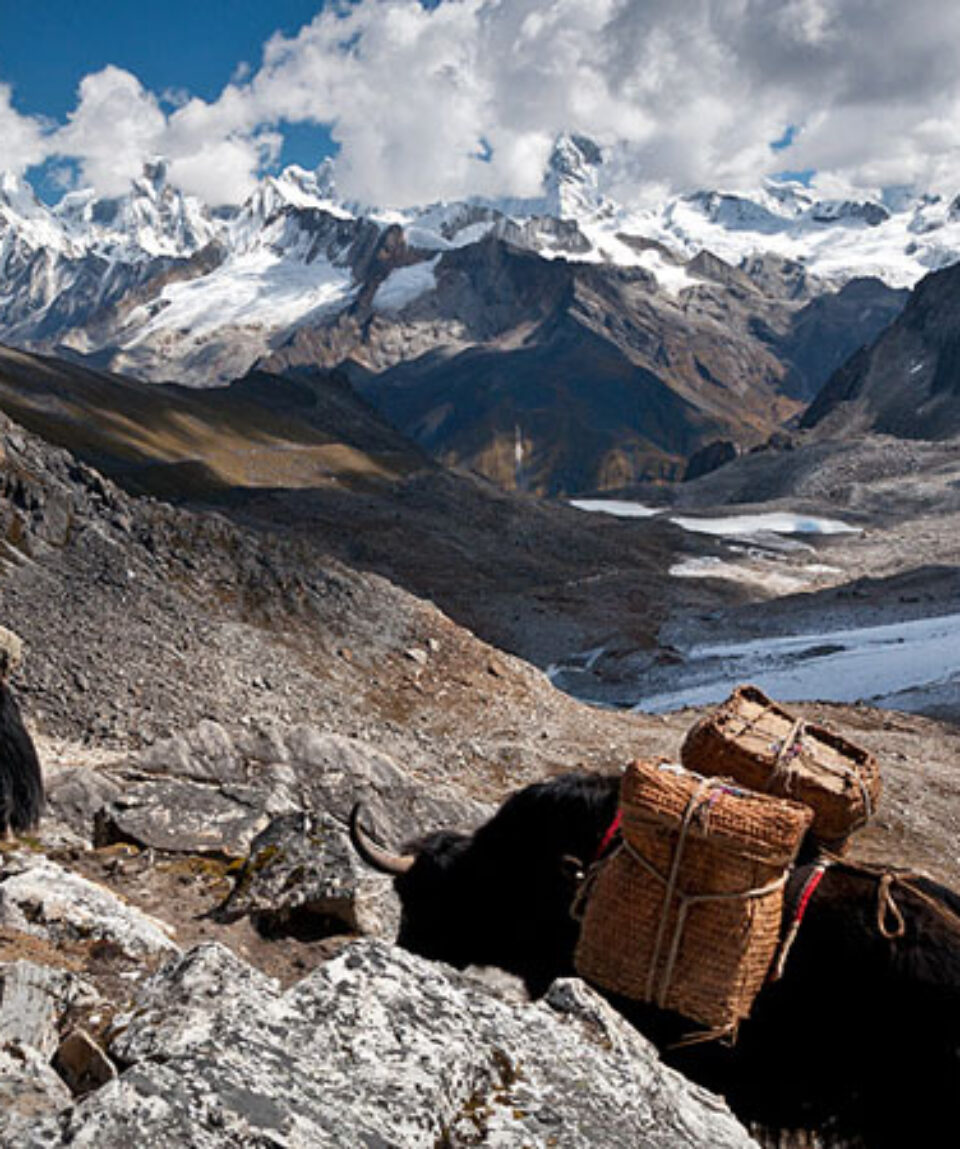Snowman Trek
fromThe ultimate traverse along Bhutan’s mountainous backbone with experience of the culturally rich region of Bhutan.
-
Reviews 0 Reviews0/5
-
Vacation Style Holiday Type
-
Hiking
-
-
Activity Level Extreme
-
Group Size Medium Group
The Snowman Trek is a challenging trek in Bhutan and ranks amongst the very finest anywhere in the Himalayas. This trek goes to the remote Lunana district and is considered to be the most difficult trek in Bhutan. The attributes making it a tough trek are; distance, high altitudes, weather conditions, and remoteness and should only be considered if you have experience and a good level of fitness.
This is one of the most famous treks in Bhutan and might be the most difficult trekking route in the world. The trek takes approximately 25 days depending on the starting point and basically traverses the mountains border region between Bhutan and Tibet starting from Paro and ending in Lunana in northern Bhutan. It crosses 11 passes the tallest of them being Gangla Karchung La at 5230m, Jaze La, 5251m, Loju La, 5155m and Rinchenzoe La, 5332m. One of the challenges of the trek is the isolation of the country being visited as there are few villages and the chances for helicopter evacuation are slim. This is truly one of the few places you are on your for an extended duration while trekking in the Himalayas.
Trip Highlights
- Visit some of Bhutan’s highest villages.
- A classic camping adventure.
- Challenge yourself on one of the greatest and most rewarding treks of the Himalaya
- Cross 11 high passes as you trek to the isolated region of Lunana
- Absorb magnificent mountain views, explore hidden valleys and bask in the serenity of high altitude lakes
- Explore Paro and its surroundings including the impressive Takstang Monastery (Tiger’s Nest)
- Experience the culturally rich region of Bhutan
- Airport transfer and escorts in Bhutan.
- All meals during the trek. (breakfast, lunch, dinner, tea, and coffee)
- Accommodation while on the trek
- Transportation as itinerary
- Tour guide throughout
- Bhutan Monuments entrance fees
- Porters and pack animals to carry trekking gear in Bhutan
- All necessary trekking permits
- Bhutan government royalty and local taxes
- All guided sightseeing in Bhutan
- Bhutanese visa
- International airfares
- International airport tax and entry visa fees
- Trekking and personal Equipment
- Any type of personal expenses, such as alcoholic beverages and drinks, phone, and laundry.
- Cost arising out of Flight Cancellation/road blockades/ landslides and events beyond our control
- Expenses of personal nature and any other expenses not mentioned in the above cost
- Tips & Gratuities to porters and guides
- Travel insurance.
- Day 1 Arrival in Paro (2,280m/7,480ft)
- Day 2 Paro Sightseeing
- Day 3 Drive past Drukyel Dzong (2580m) to Shana (2860m) and commence trek to Shiring Karup (3100m) approx 4 hrs
- Day 4 Trek from Sharna Zampa to Thangthangkha (3,610m) 7-8 hrs
- Day 5 Trek from Thangthangkha to Jangothang (4,080m) 5-6 hrs
- Day 6 Rest Day in Jangothang (4,080m)
- Day 7 Trek from Jangothang to Lingshi (4,010m) 6-7 hrs
- Day 8 Trek from Lingshi to Chebisa (3,880m) 5-6 hrs
- Day 9 Trek from Chebisa to Shomuthang (4,220m) 6-7 hrs
- Day 10 Trek from Shomuthang to Robluthang (4,160m) 6-7 hrs
- Day 11 Trek from Robluthang to Limithang (4,140m) 6-7 hrs
- Day 12 Trek from Limithang to Laya (3,850m) 4-5 hrs
- Day 13 Rest Day in Laya (3,850m)
- Day 14 Trek from Laya to Rhoduphu (4,160m) 7-8 hrs
- Day 15 Trek from Rhoduphu to Narethang (4,900m) 5-6 hrs
- Day 16 Trek from Narethang to Tarina (4,350m) 6-7 hrs
- Day 17 Trek from Tarina to Woche (4,350m) 6-7 hrs
- Day 18 Trek from Woche to Lhedi (4,200m) 6-7 hrs
- Day 19 Trek from Lhedi to Thanza (4,150m) 7-8 hrs
- Day 20 Rest Day in Thanza (4,150m)
- Day 21 Trek from Thanza to Tshochena (5,000m) 7-8 hrs
- Day 22 Trek from Tshochena to Jichu Dramo (5,050m) 4-5 hrs
- Day 23 Trek from Jichu Dramo to Chukarpo (4,600m) 5-6 hrs
- Day 24 Trek from Chukarpo to Thampe Tsho (4,300m) 6-7 hrs
- Day 25 Trek from Thampe Tsho to Maurothang (3,610m) 5-6 hrs
- Day 26 Trek from Maurothang to Sephu (2,650m)
- Day 27 Fly from Bumthang to Paro (1 hour)
- Day 28 Reserved day in Paro
- Day 29 Depart from Paro
The main emphasis while trekking is on keeping warm and dry while still being lightweight. You should bring a rucksack or backpack for the gear required during the day. Your pack should contain items such as warm clothes, a jacket, a camera, water bottles, a personal first aid kit, and snacks. The weight limit is 5kg. A porter will carry the rest of your personal equipment packed in a duffel or kit bag. The weight limit for your duffel bag is 15 kg however it is different in the case of peak climbing and expedition.
A Note on Packing
For your international flights, we recommend that you pack all your equipment in your two duffle bags or suitcase. Do not simply pack your backpack (since the straps can be damaged by the baggage handling machines). It is important to lock these bags for their trip. Depending on the airport, you may be able to put your travel locks on after TSA has searched the bags. If not, Lock the bags with Zip Ties. If the TSA cuts off the zip-tie to search your bag, they will replace it. You will still need the travel locks to lock your bags in the hotel and during the trek. Generally, you will take one duffel on the trek , and leave one in the hotel in Bhutan with your belongings for your time in the city. Your trek in duffel will only be accessible in the evenings (with items such as changes of clothing, sleeping bag), and your day pack will hold vitals such as water, layering, blister kit, and camera.
Headwear
- Sun Hat/Normal cap
- Fleece or woollen hat
- Earmuffs/Ear warmers (optional)
- Sunglasses with UV protection
- Buff Scarf / thin face mask
Handwear
- Fleece or woollen thin gloves
- Gore-Tex mitten gloves
Bodywear
- Gore-Tex Jacket
- Gore-Tex Pant
- Hiking pant
- Fleece trouser and jacket or warm jumper – Recommended not thick but warm enough that fits inside the Gore-Tex pant
- Anti-sweat T-shirt
- Thermal inner trouser
- Down jacket with hoodie
Footwear
- Trekking boots
- Hollow Out Outdoor Slipper
- Trekking socks (4-5 pair)
- Snow Gaiter
Other equipment
- Sleeping bag (comfort rated – 15 ºC)
- 30 Liter Rucksack with cover
- Large size Duffel Bag with padlock
- Headlamp with spare batteries
- Water bottles 1 Liter
- Thermos
- Basic First Aid Kit including antiseptic cream, throat lozenges, diarrhoea treatment (Imodium), altitude (Diamox), painkillers, plasters and blister treatment, insect repellent, and re-hydration salts (Dioralite). Glucose tablets and multi-vitamin tablets are also a good idea.
Washing Kit & Toiletries
- Waterproof washing kit bag
- Towel – medium size
- Washing soap, towel, tooth pest, toothbrush etc.
- Sun Lotion Enough +30SPF (including total bloc for lips, nose etc.)
- Handwash & sanitizer
- Toilet paper (you can buy this in the lodges)
- Wet tissues
Optional items
- Trekking poles
- Trainers or similar for use in the lodges
- Shorts
- Baselayer leggings
- Gaiters
- Sleeping bag liner
- Pillowcase
- Earplugs (particularly if you are not the one snoring)
- Camera
- Pen-knife (remember to pack sharp objects in hold baggage)
- Repair kit – (e.g. needle, thread, duct tape)
Conclusion:
As the weather condition is unpredictable in the Himalayan region, you need to be prepared at all times. A day can start sunny with clear skies and later become cold and windy at the high altitudes.
Sometimes, it can rain and snow during the trekking period. You need to remember that for a successful trekking journey, your physical comfort must be the first priority.
Note:
Please note that these items listed above will vary according to the season, trek duration. Please remember that your luggage will be carried by the porter, but you need to carry a daypack on your own. We also suggest you pack only necessary items to keep the weight of your equipment to a minimum.
The Snowman Trek, a nearly monthlong march through no fewer than 11 high passes, is considered one of the hardest in the world.
The best chance for good weather is during October before the snows come to the high passes and just after the monsoon ends

